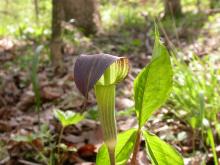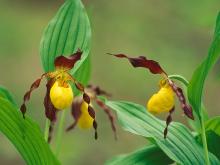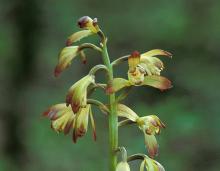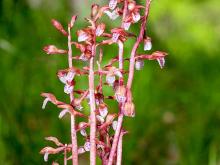Wildflowers, Grasses and Other Nonwoody Plants
Media

Species Types
Scientific Name
Arisaema triphyllum
Description
Preacher Jack in his “pulpit” is sheltered by the canopylike spathe, which is green with white and brown lengthwise markings. An unforgettable spring wildflower, Jack-in-the-pulpit is common throughout the state.
Media

Species Types
Scientific Name
Cypripedium calceolus
Description
Yellow lady’s slipper is found statewide. It is among our showiest native orchids, and suffers from its popularity. Although orchids rarely survive transplanting, people try digging them up anyway.
Media

Species Types
Scientific Name
Monotropa hypopitys
Description
Pinesap is a plant that puts the "wild" in wildflower! It lacks chlorophyll, so its roots connect to fungi underground and absorb nutrients from the fungi.
Media

Species Types
Scientific Name
Aplectrum hyemale
Description
Adam and Eve orchid is noticeable on winter woodland hikes. It is a green-and-white-striped, pleated leaf lying flat upon the dead leaves on the forest floor. Check back in May to see its flowers!
Media

Species Types
Scientific Name
Triosteum perfoliatum
Description
Even without its flowers, or its fruits that resemble miniature oranges, common horse gentian is notable for its opposite leaves, which are broadly fused together at the bases and almost appear as a single leaf with a stem going through it.
Media

Species Types
Scientific Name
Scrophularia marilandica
Description
Eastern figwort occurs statewide in rich woods, woodland borders, and bottomlands. It’s usually 2-5 feet high, has square stems and lance-shaped, toothed leaves, and bears spreading clusters of small, green scoop-shaped flowers with brown petal lobes.
Media

Species Types
Scientific Name
Hexalectris spicata (syn. Bletia spicata)
Description
Crested coral root is an orchid that lacks chlorophyll, so none of it is green. It obtains nutrients from fungi and decaying organic matter. Compared to our other coral roots, it is taller and has larger flowers. It grows in Ozark habitats.
Media

Species Types
Scientific Name
Corallorhiza wisteriana
Description
Spring coral root blooms in April and May. Except for a few small sheathing bracts along the stem, it has no leaves. The purplish or brownish flowers are in a raceme at the tip of the stem. Each flower’s lower lip is white with purple markings.
See Also
About Wildflowers, Grasses and Other Nonwoody Plants in Missouri
A very simple way of thinking about the green world is to divide the vascular plants into two groups: woody and nonwoody (or herbaceous). But this is an artificial division; many plant families include some species that are woody and some that are not. The diversity of nonwoody vascular plants is staggering! Think of all the ferns, grasses, sedges, lilies, peas, sunflowers, nightshades, milkweeds, mustards, mints, and mallows — weeds and wildflowers — and many more!





















